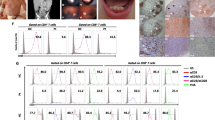Abstract
The ability of TGFβ1 to act as a potent pro-fibrotic mediator is well established, potently inducing the expression of fibrogenic genes including type I collagen (COL1A2) and CCN2. Previously we have shown elevated expression of the TGFβ accessory receptor, endoglin on Systemic Sclerosis (SSc) dermal fibroblasts. Here we sought to assess the cell surface expression of the TGFβ receptor complex on SSc dermal fibroblasts (SDF), and investigate their role in maintaining the elevated expression of CCN2. SDF exhibited elevated expression of the TGFβ accessory receptors betaglycan/TGFβRIII and endoglin, but not type I or type II receptors. To determine the effect of altered receptor repertoire on TGFβ responses, we investigated the effect of exogenous TGFβ on expression of two pro-fibrotic genes. SDF exhibited higher basal expression of COL1A2 and CCN2 compared to healthy controls. TGFβ induced a marked increase in the expression of these genes in normal dermal fibroblasts, whereas SDF exhibited only a modest increase. We next sought to determine if higher basal expression in SDF was a result of autocrine expression of TGFβ. Surprisingly basal expression was not affected by a pan-neutralizing TGFβ antibody. To explore if altered accessory receptor expression alone could account for these changes, we determined their effects on CCN2 promoter activity. Endoglin inhibited CCN2 promoter activity in response to TGFβ. TGFβRIII alone or in combination with endoglin was sufficient to enhance basal CCN2 promoter activity. Thus TGFβ accessory receptors may play a significant role in the altered expression of fibrogenic genes in SDF.



Similar content being viewed by others
References
Bilandzic M, Stenvers KL (2011) Betaglycan: a multifunctional accessory. Mol Cell Endocrinol
Burton VJ, Ciuclan LI, Holmes AM, Rodman DM, Walker C, Budd DC (2011) Bone morphogenetic protein receptor II regulates pulmonary artery endothelial cell barrier function. Blood 117:333–341
Denton CP, Zheng B, Evans LA, Shi-Wen X, Ong VH, Fisher I, Lazaridis K, Abraham DJ, Black CM, de Crombrugghe B (2003) Fibroblast-specific expression of a kinase-deficient type II transforming growth factor beta (TGFbeta) receptor leads to paradoxical activation of TGFbeta signaling pathways with fibrosis in transgenic mice. J Biol Chem 278:25109–25119
Hermida N, Lopez B, Gonzalez A, Dotor J, Lasarte JJ, Sarobe P, Borras-Cuesta F, Diez J (2009) A synthetic peptide from transforming growth factor-beta1 type III receptor prevents myocardial fibrosis in spontaneously hypertensive rats. Cardiovasc Res 81:601–609
Holmes A, Abraham DJ, Sa S, Shiwen X, Black CM, Leask A (2001) CTGF and SMADs, maintenance of scleroderma phenotype is independent of SMAD signaling. J Biol Chem 276:10594–10601
Leask A, Abraham DJ (2004) TGF-beta signaling and the fibrotic response. FASEB J 18:816–827
Leask A, Abraham DJ, Finlay DR, Holmes A, Pennington D, Shi-Wen X, Chen Y, Venstrom K, Dou X, Ponticos M, Black C, Bernabeu C, Jackman JK, Findell PR, Connolly MK (2002) Dysregulation of transforming growth factor beta signaling in scleroderma: overexpression of endoglin in cutaneous scleroderma fibroblasts. Arthritis Rheum 46:1857–1865
Leroy EC (1972) Connective tissue synthesis by scleroderma skin fibroblasts in cell culture. J Exp Med 135:1351–1362
Liu M, Suga M, Maclean AA, St George JA, Souza DW, Keshavjee S (2002) Soluble transforming growth factor-beta type III receptor gene transfection inhibits fibrous airway obliteration in a rat model of Bronchiolitis obliterans. Am J Respir Crit Care Med 165:419–423
Morris E, Chrobak I, Bujor A, Hant F, Mummery C, Ten DP, Trojanowska M (2011) Endoglin promotes TGF-beta/Smad1 signaling in scleroderma fibroblasts. J Cell Physiol
Pannu J, Nakerakanti S, Smith E, Ten DP, Trojanowska M (2007) Transforming growth factor-beta receptor type I-dependent fibrogenic gene program is mediated via activation of Smad1 and ERK1/2 pathways. J Biol Chem 282:10405–10413
Perez-Gomez E, Del CG, Juan FS, Lopez-Novoa JM, Bernabeu C, Quintanilla M (2010) The role of the TGF-beta coreceptor endoglin in cancer. ScientificWorldJournal 10:2367–2384
Ten DP, Arthur HM (2007) Extracellular control of TGFbeta signalling in vascular development and disease. Nat Rev Mol Cell Biol 8:857–869
Xu SW, Howat SL, Renzoni EA, Holmes A, Pearson JD, Dashwood MR, Bou-Gharios G, Denton CP, du Bois RM, Black CM, Leask A, Abraham DJ (2004) Endothelin-1 induces expression of matrix-associated genes in lung fibroblasts through MEK/ERK. J Biol Chem 279:23098–23103
Author information
Authors and Affiliations
Corresponding author
Rights and permissions
About this article
Cite this article
Holmes, A.M., Ponticos, M., Shi-wen, X. et al. Elevated CCN2 expression in scleroderma: a putative role for the TGFβ accessory receptors TGFβRIII and endoglin. J. Cell Commun. Signal. 5, 173–177 (2011). https://doi.org/10.1007/s12079-011-0140-4
Received:
Accepted:
Published:
Issue Date:
DOI: https://doi.org/10.1007/s12079-011-0140-4




